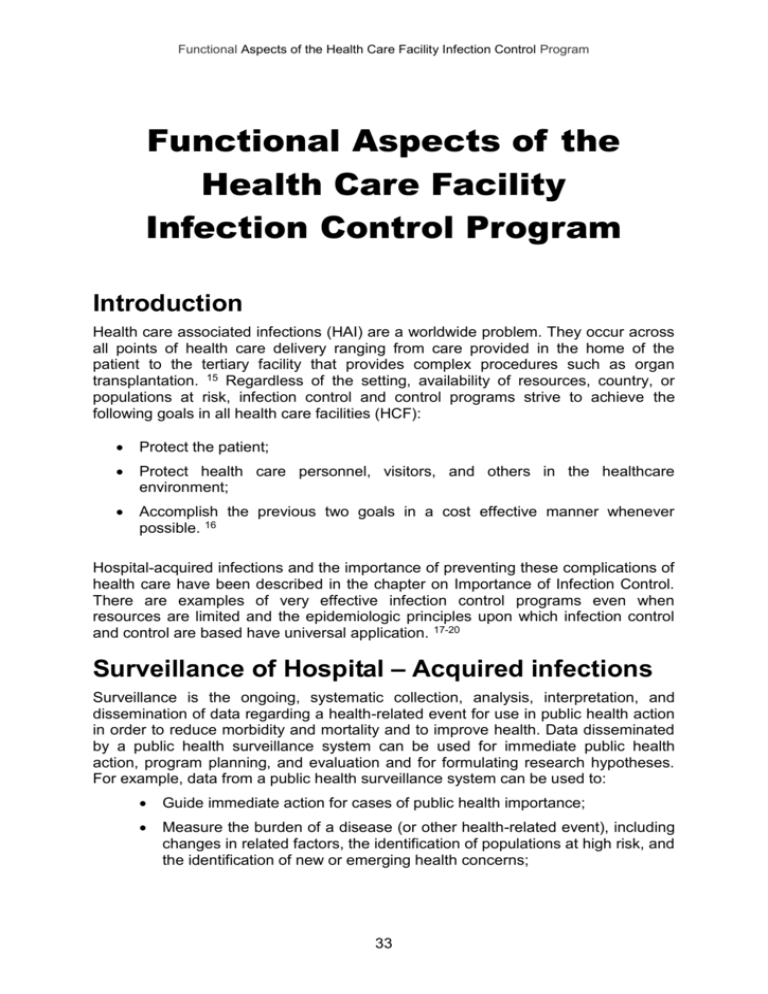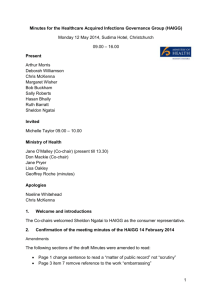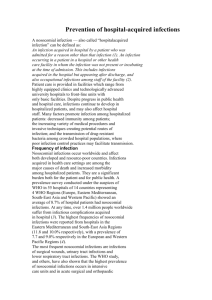Functional Aspects of the Health Care Facility Infection Control
advertisement

Functional Aspects of the Health Care Facility Infection Control Program Functional Aspects of the Health Care Facility Infection Control Program Introduction Health care associated infections (HAI) are a worldwide problem. They occur across all points of health care delivery ranging from care provided in the home of the patient to the tertiary facility that provides complex procedures such as organ transplantation. 15 Regardless of the setting, availability of resources, country, or populations at risk, infection control and control programs strive to achieve the following goals in all health care facilities (HCF): Protect the patient; Protect health care personnel, visitors, and others in the healthcare environment; Accomplish the previous two goals in a cost effective manner whenever possible. 16 Hospital-acquired infections and the importance of preventing these complications of health care have been described in the chapter on Importance of Infection Control. There are examples of very effective infection control programs even when resources are limited and the epidemiologic principles upon which infection control and control are based have universal application. 17-20 Surveillance of Hospital – Acquired infections Surveillance is the ongoing, systematic collection, analysis, interpretation, and dissemination of data regarding a health-related event for use in public health action in order to reduce morbidity and mortality and to improve health. Data disseminated by a public health surveillance system can be used for immediate public health action, program planning, and evaluation and for formulating research hypotheses. For example, data from a public health surveillance system can be used to: Guide immediate action for cases of public health importance; Measure the burden of a disease (or other health-related event), including changes in related factors, the identification of populations at high risk, and the identification of new or emerging health concerns; 33 Functional Aspects of the Health Care Facility Infection Control Program Monitor trends in the burden of a disease (or other health-related event), including the detection of epidemics (outbreaks) and pandemics; Guide the planning, implementation, and evaluation of programs to prevent and control disease, injury, or adverse exposure; Evaluate public policy; Detect changes in health practices and the effects of these changes; Prioritize the allocation of health resources; Describe the clinical course of disease; and Provide a basis for epidemiological research. 21 Surveillance of Hospital-acquired infections is a key function of the Infection Control team. The same principles of surveillance used for public health can be applied to the HCF. The major sites of Hospital-acquired infections are: Urinary tract Lower respiratory tract Surgical Site IV catheter Skin and soft tissue The relative distribution of these is illustrated graphically (Figure 5) using data derived from a prevalence survey of infections in France. 22 The steps involved in surveillance are outlined in the flow diagram (Figure 6). The collection, analysis, and dissemination of surveillance data have been shown to be the single most important factor in prevention of Hospital-acquired infections. 34 Functional Aspects of the Health Care Facility Infection Control Program Fig. 5: Sites of the most common nosocomial infections (Distribution according to the French national prevalence survey (1996)*) Adapted from (Enquete nationale de prevalence des infections nosocomiales, 1996, BEH, 1997, 36: 161-163) Fig. 6: Simplified example of steps in a surveillance system Occurrence of health-related event Health-related event recognized by reporting source Health-related event reported to responsible public health agency Feedback to stakeholders Control and prevention activities 35 Functional Aspects of the Health Care Facility Infection Control Program Some of the critical elements of a surveillance program for Hospital-acquired infections include standardized definitions and a clear purpose. The program needs to balance the resources available, the priorities for data collection (e.g., ongoing evidence of infusion-associated bloodstream infection), the population served by the facility, and the facility’s objectives. Standardized definitions have been developed. 23-24 If a facility has limited laboratory or other diagnostic facilities, more simplified definitions such as those in the table below might be helpful. When diagnostic capabilities are constrained, there have been successful examples of international collaboration using cohorts of patients with simple symptom-driven criteria for finite time periods. 25 However, if external, standardized definitions are not available, then written ones can be developed. These should emphasize intra-facility standardization. 22 Table 3: Simplified criteria for surveillance of nosocomial infections Type of nosocomial infection Simplified criteria Surgical site infection Any purulent discharge, abscess, or spreading cellulites at the surgical site during the month after the operation Urinary infection Positive urine culture (1 or 2 species ) with at least 10 bacteria/ml with or without clinical symptoms Respiratory symptoms with at least 2 of the following signs appearing during hospitalization Respiratory infection Cough Purulent sputum New infiltrate on chest radiograph consistent with infection Vascular catheter infection Inflammation, lymphangitis, or purulent discharge at the site of catheter Septicemia Fever or rigors with at least one positive blood culture One step that often is incomplete or missed in a surveillance program is dissemination of findings from the program to those who need to know, e.g., direct care personnel. A description of one such program that has been successful is the National Nosocomial Infections Surveillance (NNIS) system. 26 Recommended practices for surveillance have been described. 27 36 Functional Aspects of the Health Care Facility Infection Control Program The steps outlined in these practices are: Assess the population served by the facility so that interventions can be directed at those complications of greatest importance given available resources. Select the outcome (surgical site infection) or process (frequency that the personnel disinfect tops of stoppers in multiuse medication vials) for surveillance. Define all data elements and assure criteria definitions are valid, accurate, and reproducible. Collect the surveillance data. Calculate and analyze surveillance rates. Apply risk stratification methodology. Report and distribute surveillance information. Table 4: Prevalence and incidence rates Prevalence rate Examples Prevalence (%) of nosocomial infections (NI) for 100 hospitalized Number of infected patients* at the time of study / Number of patients observed at patients the same time x 100 Prevalence (%) of urinary tract (*or number of infections) infections (UTI) for 100 hospitalized patients Number of infected patients at the time of Prevalence (%) of UTI for 100 patients study / Number of patients exposed at with a urinary catheter the same time x 100 Attack rate (cumulative incidence Examples rate) Number of new infections acquired in a Attack rate (%) of UTI for 100 period / Number of patients observed in hospitalized patients the same period x 100 Number of new infections acquired in a Attack rate (%) of surgical site period / Number of patients exposed in infections (SSI) for 100 hospitalized the same period x 100 patients who went through surgery Incidence rate Examples Number of new nosocomial infections acquired in a period / Incidence of bloodstream infection Total of patient-days for the same period (BSI) for 1000 patient-days x 1000 Number of new device-associated nosocomial infections in a period / Incidence of ventilator-associated Total device-days for the same period pneumonia for 1000 ventilation-days x 1000 37 Functional Aspects of the Health Care Facility Infection Control Program In general, collection of numerators and denominators for the surveillance program is one that requires active methods. Passive surveillance, which relies on reports from others, has low sensitivity. Additional examples of surveillance methods and tools are available and should be reviewed for additional details. 22 Investigation and Control of Outbreaks Outbreaks or clusters of Hospital-acquired infections are usually rare. These consume <5% of the Infection Control team’s time and have an estimated frequency of 1/10,000 admissions. However when they occur, prompt investigation and control is important to prevent additional cases and to assure a return to safe care of patients. 28 Components of an outbreak investigation are: Confirmation that an outbreak or cluster exists (are the numbers unusual or more than expected?). Establishment or verification of diagnosis of observed cases; assurance of proper identification of the pathogen involved. Search for additional cases; collection of critical data and specimens (important: save isolates from the patients for molecular typing). Characterization of cases by time, place, person, procedures, equipment used, etc. Formulation of a tentative hypothesis on potential reservoir and mode of transmission. Institution of control measures as indicated and appropriation and then evaluation of the efficacy of these. Communication of findings; write final report. 38





